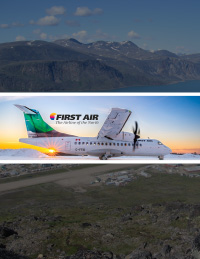Celebrating 70 years as the airline of the north
By Rajitha Sivakumaran
Pangnirtung is a small town located on Baffin Island, Nunavut. With a population of approximately 1,500 people, this Inuit hamlet sitsFirst A amongst beautiful snow-capped mountains, largely isolated from the rest of Canada. Once upon a time, these mountains prohibited the transportation of people and vital cargo via air.
Things changed when the Director of Flight Operations, Captain Aaron Speer, of First Air designed an approach that enabled the ATR 42 to land safely, while simultaneously maximizing payloads to carry both passengers and cargo. First Air, deemed the Airline of the North, is indeed a life-altering force in the snow-locked areas of Northern Canada.
“It’s still one of the most challenging airports we operate in,” Dr. Brock Friesen, First Air’s CEO, said. “But it’s a unique approach and First Air can be proud of having designed that approach and being able to fly into Pangnirtung every day.”
Pangnirtung is just one of the 29 northern communities First Air serves across the Northwest Territories and Nunavut. Without the aid of First Air, life can become very difficult for Canada’s northerners.
“It’s so important that if we were not to fly, within a few days there will not be much food left in the communities,” Friesen said. First Air delivers much-needed supplies and transports passengers for routine medical examinations and more exigent circumstances like surgeries. Non-stop flights to and from Ottawa, Montreal and Edmonton, amongst other large urban centres, help sustain life in the North. The airline transports 230,000 passengers every year in addition to 22 million kilograms of cargo and mail.
“We’re very devoted to what we do. We’re reliable in providing scheduled services and people count on us. Our customers know that we are literally the lifeline for many of the Northern communities. There’s a lot of trust and mutual respect and I think that’s what makes a real difference,” First Air’s Vice President Commercial, Bert van der Stege, said.
As the oldest airline in Canada still operating under its original name, the year 2016 marks the 70th anniversary of the company, and despite having a competitor on virtually every route they fly, First Air stands out amongst the crowd with their long history of dependable service.
Innovative from the very beginning
Innovative ideas have been a major part of the company since its inception. In 1958, when founders Russel Bradley and Weldy Phipps, working under contract with the Geological Survey of Canada, mounted “tundra tires” onto their two-seat monoplane, a world of possibilities opened up. Quite suddenly, landing in the ice-ridden North was not a problem. Operating under the name Bradley Air Services, the airline became the go-to company for scientific and government expeditions to the Arctic. The coming years entailed a fleet enlargement and further expansion through the acquisition of Ptarmigan Airways of Yellowknife and NWT Air. Since then, the company has been continually expanding its service area.
First Air has achieved a number of industry firsts during its 70 years. In 2011, it was the first in the world to use an ATR 72-212 with Variable Combi equipped with a custom designed cargo handling system. In the same year, First Air, in collaboration with Qikiqtaaluk Corporation, launched Qikiqtani First Aviation Ltd., a joint-venture that would serve the Baffin region. Code sharing has allowed for further expansion. Since 2012, First Air has been offering seasonal service to Nuuk, the capital of Greenland, via Air Greenland. This year, the company has emerged as the first operator in Canada to use the ATR 42-500.
Overcoming challenges in the Great White North
“Northern Canada is unusual to anyone who’s never been there,” van der Stege said. This extraordinary chunk of territory constantly tests the strength of the airline, primarily through taxing weather. Extreme weather conditions hinder accessibility to communities of the North and endanger safe landing. Poor infrastructure, including a low number of paved runways, poses another challenge. The majority of these communities have a gravel runway with very limited infrastructure.
The high cost of operating in Northern Canada is yet another challenge of the industry. For instance, the price of fuel, a necessity for all airlines, is three times higher in Northern Canada than it is in the south. While southern airlines, like Air Canada, are profiting considerably from recent drops in fuel price, First Air still spends an immense amount of capital on fuel.
“Airlines in Canada have to be self-sufficient,” Friesen said. He attests to the difficulties of being an airline operator in Canada, where government subsidies are not provided to aid vital air transport operation. In contrast, the U.S. and Europe follow business models that incorporate governmental funding for essential air transportation or public service obligation routes.
When van der Stege arrived in Canada in 2013 to assume his executive position with First Air, he brought with him years of international experience in the field of aviation. However, he joined the company at a critical time, a period of change and restructuring in response to operational and strategic struggles. The company had faced substantial losses over the past five years prior to the start of the restructuring, but the losses and uncertainty around its future were short-lived. Working alongside Dr. Friesen, van der Stege and his team have overseen the implementation of the transformation.
“The beauty of First Air is that we have a very loyal, a very dedicated workforce. Lots of people wanting to work very hard and making a real difference in the day-to-day life of our customers’ experience, every single day,” van der Stege said.
By 2014, the company admitted that the business model they had was simply too complex. For example, having certain types of aircraft didn’t make economic sense, van der Stege said, and this consequently led to inefficiencies and the elimination of several types of aircraft to improve its cost base.
The year 2014 emerged as the year of change, and consequently, First Air enjoyed a profitable 2015 and a positive cash flow. The present year has been devoted to fleet modernization in order to set the wheels of growth in motion. The airline has invested more than $110 million into new aircraft this year. The newest ATR procurements are presently being integrated into the fleet with an additional Boeing 737-400 having joined the fleet in April.
Giving globally and nationally
In the midst of the 2010 earthquake that devastated Haiti, First Air dispatched some of their fleet to aid relief efforts, constantly flying back and forth between Canada and Haiti, transporting clothing and medical and housing supplies. Closer to home, First Air launches rescue missions to Canada’s northern communities often due to extreme weather. Similar to the Haiti relief efforts, First Air brings in critical materials and goods to aid the public.
Presently owned by Makivik Corp., an Inuit-owned organization, the airline contributes to the wellbeing of northerners in other ways too. “One of our philosophies is to give back to the communities we serve,” van der Stege said. This includes economic development, educational programs and sporting events. Every year, the company selects initiatives worthy of recognition, financial help or sponsorship.
First Air is one of the largest private employers in Northern Canada. In addition to jobs, internships are offered to supply firsthand work experience in the industry. “We’re very proud to have a large number of Inuit employees as well as employees who are permanently based in the North. We think that is a great way to create jobs and contribute to the local economy,” Friesen noted.
About 450 out of the nearly 1,000 First Air employees contribute in such a way, by living and spending money in the North. Being an airline, First Air brings in much needed investment opportunities and entrepreneurs who are willing to invest and do business in the North. The airline, of course, also brings in tourists to give the economy an additional boost. It also facilitates and supports economic conferences and tradeshows by contributing to panel discussions and giving presentations on new ideas and developments. “We truly believe that education is key in the development of Northern Canada, so that’s an area close to our heart,” Friesen said.
“Though hockey occupies a place in the hearts of many Canadians, it seems as though it is nowhere as important as it is in Northern Canada,” van der Stege said. In addition to bringing sporting equipment to the communities it serves, First Air hosted the Stanley Cup in Canada’s North. This was the first time the Cup had traveled so far north.
“We aim to continue to provide top-class service and be that reliable service provider that Northerners need,” Friesen said.
www.firstair.ca







